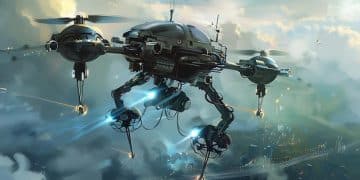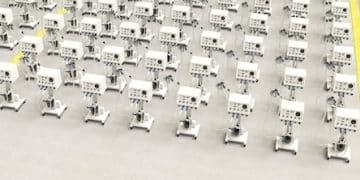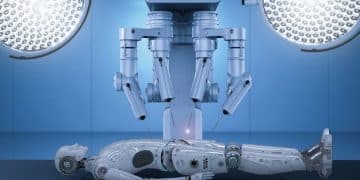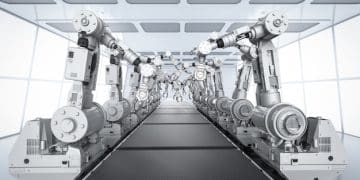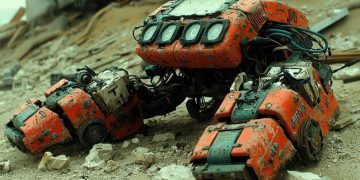Robotics and US Space Exploration: How Robots Aid NASA Mars Missions
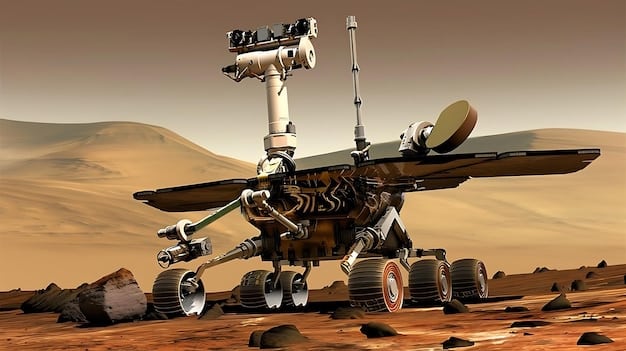
Robotics and US space exploration are deeply intertwined, with advanced autonomous systems proving essential to NASA’s efforts to explore Mars, collecting vast amounts of data and performing critical tasks in environments too hostile for human presence, thereby expanding our understanding of the Red Planet.
The synergy between robotics and US space exploration has fundamentally transformed humanity’s reach beyond Earth, particularly in our ambitious quest to unravel the mysteries of Mars. These sophisticated machines serve as our vanguard, meticulously navigating the Red Planet’s harsh terrains and transmitting invaluable data back home, pushing the boundaries of what is possible in extraterrestrial discovery.
The Indispensable Role of Robotics in Martian Exploration
Robotics stands as the cornerstone of contemporary US space exploration, especially when eyes turn towards Mars. The sheer distance, prohibitive costs, and inimical environment make sending humans impractical for initial reconnaissance and long-term scientific study. Robots, therefore, become our proxies, tirelessly working in conditions that would be lethal to astronauts.
These mechanical explorers are not mere automatons; they are complex systems capable of independent decision-making, precise manipulation, and robust data collection. Their design incorporates advanced engineering, materials science, and artificial intelligence, enabling them to endure extreme temperature fluctuations, radiation exposure, and fine dust that permeate the Martian atmosphere.
Early Robotic Pioneers on Mars
The journey of robotic exploration on Mars began decades ago, with early landers providing foundational insights into the planet’s surface conditions. These missions, though simpler by today’s standards, laid the groundwork for the more complex rovers that followed, establishing the viability of robotic presence thousands of miles away.
- Viking 1 and 2 (1976): First successful US landers on Mars, seeking signs of life and conducting surface analyses.
- Mars Pathfinder and Sojourner (1997): Demonstrated the feasibility of mobile rovers on Mars, paving the way for larger missions.
- Spirit and Opportunity (2004): Twin rovers that far exceeded their expected lifespan, discovering evidence of past water on Mars.
Each successive mission built upon the experiences and data of its predecessors, iteratively improving both the hardware and the operational strategies. This continuous evolution has resulted in the sophisticated robots we see exploring Mars today, demonstrating a commitment to technological advancement.
The lessons learned from these early missions were invaluable, guiding the development of more resilient components, enhanced power sources, and increasingly autonomous navigation systems. This iterative process is crucial for the ongoing success of robotic missions, ensuring that each new explorer is better equipped to face the challenges of the Martian environment.
Ultimately, the role of robotics extends beyond mere exploration. These machines are pathfinders, preparing the way for potential future human missions by characterizing the environment, identifying resources, and testing technologies that will be critical for human survival on the Red Planet. Their contributions are fundamental to NASA’s long-term vision for space exploration.
Advanced Capabilities of Modern Mars Rovers
Modern Mars rovers represent the zenith of robotic engineering, showcasing unparalleled capabilities that allow for intricate scientific investigation. These rolling laboratories are equipped with a suite of instruments designed to analyze Martian geology, atmospheric conditions, and the potential for past or present microbial life.
Their mobility systems are refined to traverse challenging terrains, from rocky outcrops to sandy dunes, ensuring access to diverse geological sampling sites. The precision of their robotic arms and drills enables the collection of samples that are then analyzed by onboard miniature laboratories, providing real-time scientific data.
Scientific Instrumentation and Data Collection
The instruments aboard rovers like Curiosity and Perseverance are marvels of miniaturization and multidisciplinary engineering. They can identify mineral compositions, detect organic molecules, and even analyze ancient environmental conditions locked within rocks and soil samples.
- Spectrometers: Used to identify the chemical composition of rocks and soils.
- Cameras: High-resolution imaging systems provide panoramic views and detailed close-ups of geological features.
- Environmental Sensors: Measure temperature, pressure, wind speed, and radiation levels.
The data collected is transmitted back to Earth, often via orbiting satellites, forming the foundation for scientific papers, new hypotheses, and a continually deepening understanding of Mars’s history and potential for habitability. This continuous flow of information is vital for the scientific community.
Beyond the primary scientific goals, these rovers also act as engineering testbeds. They validate technologies that could be used in future human missions, such as power generation, dust mitigation, and precision landing systems. Every operational hour provides valuable data for future mission planning.
The computational power on board allows for a degree of autonomy, enabling the rovers to make limited decisions about navigation and scientific targeting without constant human intervention. This capability is critical given the significant communication delay between Earth and Mars.
Navigation, Autonomy, and Communication Challenges
Operating a robot millions of miles away presents a unique set of challenges, particularly concerning navigation, autonomy, and communication. The time delay for signals to travel between Earth and Mars can range from 3 to 22 minutes one way, making real-time remote control impossible.
Therefore, Mars rovers must possess a significant degree of autonomy. Engineers upload sequences of commands, but the robots themselves must interpret these commands and execute them, often adapting to unforeseen obstacles or terrain variations using their onboard intelligence.
Autonomous Navigation and Hazard Avoidance
To navigate the treacherous Martian landscape, rovers employ sophisticated autonomous navigation systems. These systems use internal maps, visual odometry, and hazard detection algorithms to plan safe routes and avoid obstacles like large rocks, steep slopes, or unstable ground.
- Visual Odometry: Uses successive camera images to track movement and estimate distance traveled.
- Hazard Avoidance Cameras (Hazcams): Provide stereoscopic views for identifying obstacles directly in the rover’s path.
- Terrain Relative Navigation: Recent advancement allowing precise landing by comparing live images with orbital maps.
When an obstacle is detected, the rover can either adjust its path autonomously or, if the hazard is too great, halt and await further instructions from Earth. This balance between autonomy and ground control oversight is crucial for mission safety and efficiency.

Communication with Earth is primarily carried out through high-gain antennas that send data directly or relay it via orbiting spacecraft like the Mars Reconnaissance Orbiter. These orbiters play a vital role as communication relays, improving data downlink rates and mission flexibility.
The complexity of managing these long-distance communications, including dealing with solar conjunctions that temporarily block signals, underscores the sophisticated planning and technology required for successful Mars missions. The entire system is a testament to human ingenuity.
The Ingenuity Helicopter and Future Aerial Exploration
The Mars Helicopter Ingenuity, deployed from the Perseverance rover, marked a pivotal moment in robotic space exploration. It was the first powered, controlled flight on another planet, opening up an entirely new dimension for Martian reconnaissance and exploration.
Ingenuity’s success has demonstrated the feasibility of aerial platforms on Mars, offering a unique perspective that ground-based rovers cannot achieve. Its limited yet impactful flights have proven that the thin Martian atmosphere can support sustained flight with the right design and power.
Benefits of Martian Aerial Platforms
Aerial vehicles offer considerable advantages for exploring Mars. They can rapidly survey vast areas, access difficult-to-reach terrains like cliff faces and deep craters, and provide high-resolution imagery for future mission planning.
- Enhanced Reconnaissance: Quickly identify areas of scientific interest or potential hazards for rovers.
- Access to Inaccessible Terrain: Reach locations that ground-based vehicles cannot, such as steep slopes and ravines.
- Broader Perspective: Offer bird’s-eye views for geological mapping and route planning.
The success of Ingenuity is now paving the way for more ambitious aerial missions, including larger drones or even small aircraft designed for extended flight durations and diverse payloads. Such platforms could revolutionize how we explore Mars, making it possible to cover more ground and gather data from new vantage points.
This expansion into aerial exploration complements the ground-based efforts of rovers, creating a multi-layered approach to understanding the Red Planet. The combined capabilities of rovers and helicopters enhance our scientific return and improve the efficiency of exploration endeavors significantly.
Future aerial missions could potentially carry more advanced scientific instruments, allowing for atmospheric profiling, detailed surface morphology studies, and even the search for subsurface water ice without requiring extensive ground-based traversal. The potential is immense.
Robots as Precursors to Human Missions
While robots are indispensable for current Mars exploration, their ultimate role extends to preparing the Red Planet for future human presence. Every piece of data collected, every engineering challenge overcome, brings NASA closer to safely landing and sustaining human life on Mars.
Robots are actively engaged in tasks that are critical for future human missions, from mapping potential landing sites and identifying resource locations to monitoring radiation levels and assessing the long-term effects of the Martian environment on equipment and materials.
Key Preparatory Tasks Performed by Robots
The work of current and future robots is multifaceted, designed to mitigate risks and lay the groundwork for eventual human expeditions. This includes environmental monitoring, resource prospecting, and infrastructure development.
- Resource Identification: Locating water ice deposits essential for drinking, oxygen production, and rocket fuel.
- Environmental Monitoring: Measuring radiation, atmospheric conditions, and dust storms to understand risks to human health and equipment.
- Site Selection: Identifying safe and scientifically rich landing and habitation sites for future astronauts.
Tasks like the MOXIE (Mars Oxygen In-Situ Resource Utilization Experiment) aboard Perseverance demonstrate how robots can test technologies vital for human survival, such as producing breathable oxygen from the Martian atmosphere. These are not merely scientific experiments but engineering precursors.
Furthermore, robots can assist in the construction of habitats or landing pads prior to human arrival, reducing the risks and workloads for early human crews. This pre-deployment of infrastructure could significantly enhance mission safety and efficiency.
The data from robotic missions also informs the design of human habitats, life support systems, and countermeasures for radiation exposure. In essence, robots are acting as advance teams, meticulously gathering intelligence and proving technologies necessary for the next giant leap for humankind.
Ethical Considerations and the Future of Robotic Exploration
As robotic capabilities continue to advance, so do the ethical considerations surrounding their deployment, particularly when it comes to planetary protection and the potential for life detection. Preventing contamination of other planets with Earth microbes is paramount.
NASA adheres to strict planetary protection protocols to ensure that its robotic missions do not inadvertently introduce terrestrial life forms to Mars, which could compromise the search for indigenous life or alter the Martian environment fundamentally.
Ensuring Planetary Protection and Responsible Exploration
The design and assembly of Mars-bound robots involve rigorous sterilization processes to minimize biological contamination. This commitment reflects a deep respect for the potential for extraterrestrial life and the integrity of scientific discovery.
- Sterilization Protocols: Strict cleaning and sterilization of spacecraft components and instruments before launch.
- Orbital Insertion: Careful planning of trajectories to avoid accidental impact with regions of high biological interest.
- Contamination Control: Ongoing efforts to prevent backward contamination if Martian samples are returned to Earth.
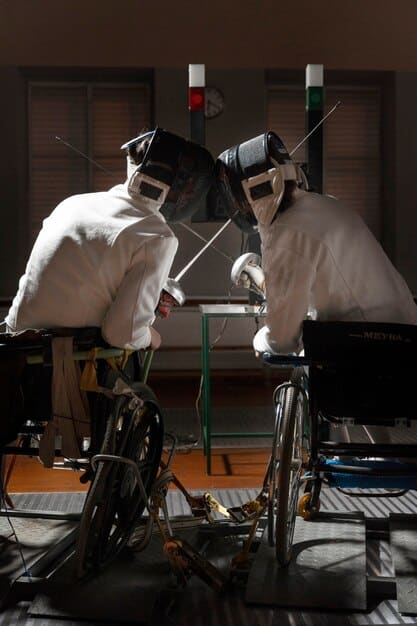
Looking ahead, the future of robotic exploration promises even greater autonomy, intelligence, and collaborative capabilities. Swarms of smaller, highly specialized robots could work together, sharing data and completing complex tasks more efficiently than a single large rover.
Advances in artificial intelligence and machine learning will empower robots to conduct more independent scientific investigations, make complex decisions in real-time, and adapt to unpredictable environments without constant human oversight. This evolution will accelerate discovery.
Ultimately, the aim is to push the boundaries of knowledge and prepare humanity for an eventual sustained presence beyond Earth. Robotics will remain at the forefront of this endeavor, transforming our understanding of the universe one autonomous mission at a time. The intertwined future of robotics and US space exploration is undoubtedly bright.
| Key Aspect | Brief Description |
|---|---|
| 🚀 Primary Role | Robots are essential for exploring Mars, overcoming distance and hostile conditions. |
| 🔬 Scientific Impact | Rovers collect vital data on geology, atmosphere, and signs of past water. |
| 🧭 Autonomy & Nav. | Advanced systems allow rovers to navigate and avoid hazards independently. |
| 🛰️ Future Outlook | Includes aerial exploration (Ingenuity) and preparing Mars for human missions. |
Frequently Asked Questions About Robotics in Mars Exploration
Robots are favored for Mars exploration due to the immense distance, high costs, and the extremely hostile Martian environment. Conditions like harsh radiation, extreme temperatures, and a toxic atmosphere make it unfeasible and dangerous for initial human missions. Robots can operate continuously without immediate life support, gathering critical data and taking risks humans cannot.
Mars rovers use sophisticated autonomous navigation systems that combine visual odometry from cameras with hazard avoidance sensors. They build 3D maps of their surroundings, identifying obstacles such as rocks and steep slopes. Onboard AI algorithms then calculate safe paths, allowing the rover to move without continuous real-time input from Earth, which is crucial given the communication delays.
Modern Mars rovers like Perseverance are equipped with a diverse array of scientific instruments. These include spectrometers for chemical and mineral analysis, high-resolution cameras for imaging, drills and robotic arms for sample collection, and environmental sensors to measure temperature, pressure, and radiation. They also carry specialized instruments like MOXIE for in-situ resource utilization experiments.
The Ingenuity helicopter demonstrated the first powered, controlled flight on another planet. It serves as a proof of concept for aerial exploration, showing that flight is possible in Mars’s thin atmosphere. Ingenuity provided unique aerial perspectives, scouted terrain, and helped plan rover routes, paving the way for future, more complex aerial vehicles crucial for broader reconnaissance and access to difficult areas.
Robotic missions are critical precursors to human exploration. They identify crucial resources like water ice, characterize environmental conditions (radiation, dust), and assess potential landing and habitation sites. Technologies like MOXIE, which produces oxygen from the Martian atmosphere, are tested by robots, reducing risks and informing the design of life support systems for future human crews, ultimately laying essential groundwork.
Conclusion
The intricate dance between robotics and US space exploration has undeniably propelled humanity’s understanding of Mars to unprecedented levels. From the perseverance of rovers diligently analyzing Martian geology to the innovative flights of the Ingenuity helicopter providing new perspectives, robots are the unsung heroes of our journey to the Red Planet. Their capabilities, continually advancing through sophisticated engineering and AI, allow us to explore, discover, and prepare for a future where human footsteps may one day grace Martian soil. As technology progresses, so too will the depth and breadth of our interplanetary endeavors, with autonomous systems remaining at the vanguard of exploration.

